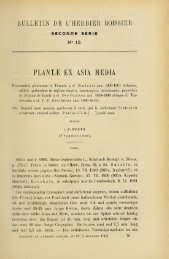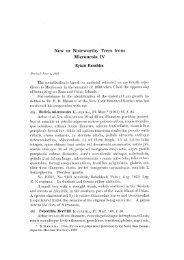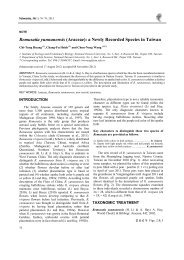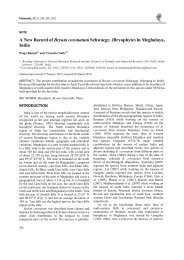Two Species of Bacidia (Lichenized Ascomycota) New to India
Two Species of Bacidia (Lichenized Ascomycota) New to India
Two Species of Bacidia (Lichenized Ascomycota) New to India
You also want an ePaper? Increase the reach of your titles
YUMPU automatically turns print PDFs into web optimized ePapers that Google loves.
Taiwania, 57(3): 305-307, 2012<br />
NOTE<br />
<strong>Two</strong> <strong>Species</strong> <strong>of</strong> <strong>Bacidia</strong> (<strong>Lichenized</strong> <strong>Ascomycota</strong>) <strong>New</strong> <strong>to</strong> <strong>India</strong><br />
Siljo Joseph (1) and Gopal Prasad Sinha (1*)<br />
1. Botanical Survey <strong>of</strong> <strong>India</strong>, Central Regional Circle, 10-Chatham Lines, Allahabad -211 002, <strong>India</strong>.<br />
* Corresponding author. Email: drgpsinha@gmail.com<br />
(Manuscript received 8 Febuary 2012; accepted 30 March 2012)<br />
ABSTRACT: <strong>Two</strong> lichen species, <strong>Bacidia</strong> arceutina (Ach.) Rehm & Arnold and B. heterochroa (Müll. Arg.) Zahlbr., from Sikkim<br />
are reported as new <strong>to</strong> <strong>India</strong>.<br />
KEY WORDS: <strong>Bacidia</strong>, new record, Ramalinaceae, taxonomy.<br />
INTRODUCTION<br />
<strong>Bacidia</strong> De Not. is a cosmopolitan genus with over<br />
229 species worldwide (Kirk et al., 2008). The <strong>India</strong>n<br />
species <strong>of</strong> <strong>Bacidia</strong> are known by the treatment <strong>of</strong><br />
Awasthi and Mathur (1987) wherein 18 species were<br />
dealt, followed by a key <strong>of</strong> 27 species (Awasthi, 1991).<br />
Recently Singh and Sinha (2010) listed 28 species and 2<br />
varieties in checklist <strong>of</strong> <strong>India</strong>n lichens. Ongoing<br />
investigation on the microlichen flora <strong>of</strong> Sikkim revealed<br />
two additional species <strong>of</strong> <strong>Bacidia</strong> new <strong>to</strong> <strong>India</strong>. A<br />
detailed account comprising taxonomic descriptions and<br />
figures are provided.<br />
MATERIALS AND METHODS<br />
The examined specimens are housed at BSA<br />
(Botanical Survey <strong>of</strong> <strong>India</strong>, Allahabad) herbarium.<br />
Morphological and ana<strong>to</strong>mical characters were studied<br />
by using Motic SMZ-168 and Nikon Eclipse 50i<br />
microscopes. All measurements were made on materials<br />
mounted in distilled water. Chemical analysis was<br />
performed with usual spot tests and thin layer<br />
chroma<strong>to</strong>graphy following Orange et al. (2001).<br />
TAXONOMIC TREATMENTS<br />
<strong>Bacidia</strong> arceutina (Ach.) Rehm & Arnold, Verh.<br />
Zool.-Bot. Ges. Wien 19: 624. 1869. Lecidea luteola<br />
var. arceutina Ach., Method. Lich.: 61. 1803.<br />
Figs. 1A-E<br />
Thallus corticolous, crus<strong>to</strong>se, epiphloedal, pale grey,<br />
continuous <strong>to</strong> rimose, verruculose, ± granular, soredia<br />
and isidia absent. Apothecia 0.2-1 mm diam., sessile, ±<br />
yellowish when young, reddish brown at maturity,<br />
margin slightly raised and concolorous with disc when<br />
young, reaching the level <strong>of</strong> disc and dark brown at<br />
maturity, finally excluded; disc slightly concave <strong>to</strong><br />
plane, pale brown <strong>to</strong> yellowish brown when young,<br />
slightly convex, reddish brown at maturity, finally dark<br />
brown in old apothecia, epurniose. Excipulum 60-95<br />
µm thick laterally; upper part pale yellow <strong>to</strong> pale<br />
reddish brown, pale brownish <strong>to</strong> yellow brown at<br />
margin, inner part pale yellowish brown or hyaline;<br />
100-125 µm thick at base, hyaline or pale yellowish,<br />
lighter than hypothecium. Epihymenium brownish, K-.<br />
Hymenium hyaline, ± brownish yellow in upper part,<br />
70-90 µm high, K-, I+ blue, K/I+ deep blue.<br />
Hypothecium ± yellowish, K+ intensifying, 20-35 µm<br />
thick. Paraphyses ± branched in upper part, 0.8-1.5 µm<br />
thick, not or slightly thickened at apices. Asci 8-spored.<br />
Ascospores hyaline, (-5)7-12(-16)-septate, straight,<br />
acicular, 48.5-74.5 × 1.5-2.8(-3.4) µm. Pycinidia not<br />
seen.<br />
Chemistry: Thallus K-, C-, KC-, PD-, UV-; no<br />
lichen substances detected in TLC.<br />
Distribution: North America, Southern Europe<br />
(Spain, Italy, Greece), Northern Europe (Norway,<br />
Sweden, Es<strong>to</strong>nia), Western Europe (Germany), Eastern<br />
Europe (Hungary), Western Asia (Turkey) and East<br />
Asia (South Korea).<br />
Remarks: B. arceutina is easily <strong>to</strong> be confused with<br />
B. laurocerasi (Delise ex Duby) Zahlbr. and B.<br />
salmonea S. Ekman (Ekman, 1996). B. laurocerasi,<br />
which is known from <strong>India</strong>, differs from B. arceutina by<br />
shorter and narrower spores with fewer septa while B.<br />
arceutina can be separated from B. salmonea by the<br />
presence <strong>of</strong> brown yellow pigment in the apothecia.<br />
Specimen examined: INDIA - Sikkim, Samdruptse, 2138 m,<br />
26.11.2006. G.P.Sinha 3818 (BSA).<br />
<strong>Bacidia</strong> heterochroa (Müll. Arg.) Zahlbr., Cat. Lich.<br />
Univ. 4: 204. 1926. Patellaria heterochroa Müll.<br />
Arg., Flora 63: 280. 1880. Figs. 1F-J<br />
305
306<br />
Taiwania Vol. 57, No. 3<br />
Fig. 1. A-E: <strong>Bacidia</strong> arceutina (Müll. Arg.) Zahlbr. A-B: Habit. C: Section <strong>of</strong> apothecia. D: Exciple enlarged. E: Ascospores. F-J:<br />
<strong>Bacidia</strong> heterochroa (Müll. Arg.) Zahlbr. F-G: Habit. H: Section <strong>of</strong> apothecia. I: Exciple enlarged. J: Ascospores. Scale bars:<br />
A-B & F-G: 1 mm; C-D & H-I: 100 µm; E & J: 15 µm.
September, 2012 Joseph & Sinha: <strong>Two</strong> <strong>Bacidia</strong> new <strong>to</strong> <strong>India</strong><br />
Thallus corticolous, crus<strong>to</strong>se, epiphloedal,<br />
continuous <strong>to</strong> rimose, verruculose, pale yellowish,<br />
soredia and isidia absent. Apothecia 0.5-1 mm diam.,<br />
sessile, dark brownish, margin slightly raised,<br />
concolorous <strong>to</strong> disc when young, ± dark at maturity; disc<br />
slightly concave <strong>to</strong> plane, pale yellow brown when<br />
young, becoming slightly convex, brownish <strong>to</strong> black at<br />
maturity, epruinose. Excipulum 57-107 µm thick<br />
laterally, red brown at margin and upper part, K+<br />
intensifying or purple, inner part hyaline <strong>to</strong> pale yellow,<br />
lighter than margin; 90-154(-220) µm thick at base,<br />
hyaline with some aggregations. Epihymenium K+<br />
intensifying. Hymenium 82-112(-130) µm high, lower<br />
part hyaline, I+ blue, K-, upper part reddish brown, K+<br />
intensifying or purple, I+ vinose red. Hypothecium pale<br />
yellowish, K+ intensifying, 40-70 µm thick. Paraphyses<br />
± branched in upper part, 0.6-1.6 µm thick, not or<br />
slightly thickened at apices. Asci 8-spored. Ascospores<br />
hyaline, 8-15-septate, not coiled within asci, straight or ±<br />
curved, acicular, 54.2-77.4 × 2.2-3.0(-3.5) µm. Pycinidia<br />
not seen.<br />
Chemistry: Thallus K+ pale yellow, C-, KC-, PD-,<br />
UV-; atranorin (trace) detected in TLC.<br />
Distribution: Pantropical species, extending in<strong>to</strong><br />
warm-temperate, coastal areas <strong>of</strong> the world, known from<br />
all continents and possibly the most widespread species<br />
<strong>of</strong> <strong>Bacidia</strong> on earth (Ekman, 2004).<br />
Remarks: The specimens containing traces <strong>of</strong><br />
atranorin were reported from the eastern U.S. (Ekman<br />
1996). However, atranorin is reported <strong>to</strong> be absent in<br />
specimens from other areas.<br />
Specimen examined: <strong>India</strong>-Sikkim, Tendong Biodiversity<br />
Park, 2009 m, 26.11.2006. G.P. Sinha 3812 (BSA).<br />
印度的兩種桿孢衣屬(子囊菌門)新紀錄種<br />
Siljo Joseph (1) and Gopal Prasad Sinha (1*)<br />
ACKNOWLEDGEMENTS<br />
The authors thank Dr. Parmjit Singh, Direc<strong>to</strong>r, Botanical<br />
Survey <strong>of</strong> <strong>India</strong>, Kolkata and Dr. A. A. Ansari, Scientist - E &<br />
Head <strong>of</strong> Office, B. S. I, Allahabad for providing facilities.<br />
LITERATURE CITED<br />
Awasthi, D. D. 1991. A Key <strong>to</strong> the microlichens <strong>of</strong> <strong>India</strong>,<br />
Nepal and Sri Lanka. Biblioth. Lichenol. 40: 1-337.<br />
Awasthi, D. D. and R. Mathur. 1987. <strong>Species</strong> <strong>of</strong> the lichen<br />
genera <strong>Bacidia</strong>, Badimia, Fellhanera and Mycobilimbia<br />
from <strong>India</strong>. Proc. <strong>India</strong>n Acad. Sci., Pl. Sci. 97: 481-503.<br />
Ekman, S. 1996. The corticolous and lignicolous species <strong>of</strong><br />
<strong>Bacidia</strong> and Bacidina in North America. Opera Bot. 127:<br />
1-148.<br />
Ekman, S. 2004. <strong>Bacidia</strong>. In: Nash III, T.H. et al. (eds.),<br />
Lichen Flora <strong>of</strong> the Greater Sonoran Desert Region, 2:<br />
18-28. Tempe: Lichens Unlimited, Arizona State<br />
University.<br />
Kirk, P. M., P. F. Cannon, D. W. Minter and J. A. Stalpers<br />
(eds.). 2008. Ainsworth and Bisby’s Dictionary <strong>of</strong> the<br />
Fungi. 10 th ed. CAB International Publishing. 771 pp.<br />
Orange, A., P. W. James and F. J. White. 2001.<br />
Microchemical Methods for the Identification <strong>of</strong> Lichens.<br />
British Lichen Society. 101pp.<br />
Singh, K. P. and G. P. Sinha. 2010. <strong>India</strong>n Lichens: An<br />
Annotated Checklist. Botanical Survey <strong>of</strong> <strong>India</strong>. 571pp.<br />
1. Botanical Survey <strong>of</strong> <strong>India</strong>, Central Regional Circle, 10-Chatham Lines, Allahabad -211 002, <strong>India</strong>.<br />
* 通信作者。Email: drgpsinha@gmail.com<br />
(收稿日期: 2012 年 2 月 8 日;接受日期: 2012 年 3 月 30 日)<br />
摘要:本文報導了在印度錫金邦發現的兩個地衣新紀錄分佈:<strong>Bacidia</strong> arceutina (Ach.) Rehm<br />
& Arnold 和 B. heterochroa (Müll. Arg.) Zahlbr.<br />
關鍵詞:桿孢衣屬、新紀錄種、樹花科、分類學。<br />
307








